Varanasi travel - India, Asia
Varanasi, also known as Benares or Kashi, one of the world's oldest continuously inhabited cities, sits majestically on the banks of the sacred Ganges River in northern India. This spiritual capital of Hinduism captivates visitors with its ancient ghats (riverfront steps) where pilgrims perform rituals, the mesmerizing Ganga Aarti ceremony at dusk, and a labyrinth of narrow alleys filled with temples and bustling bazaars. Travelers flock to Varanasi to witness the cycle of life and death, explore its rich cultural tapestry, and experience the mystical atmosphere that permeates the city. The city is also renowned for its silk weaving, classical music, and flavorful street food, particularly its famous lassi and chaat.
Notable features include the iconic Kashi Vishwanath Temple, dedicated to Lord Shiva, and the famous Ganga Aarti ceremony held at Dashashwamedh Ghat, where visitors can witness the mesmerizing rituals performed in honor of the Ganges. Varanasi is also close to Sarnath, where Buddha delivered his first sermon, adding to its importance as a center for Buddhism.
Population: Estimate 1,800,000 people (as of 2024)
Economy: Silk weaving is the dominant manufacturing industry, with Varanasi famous for its fine silk and Banarasi saris. The city is known for handicrafts like hand-knotted carpets, brassware, copperware, wooden and clay toys, and gold jewelry. Tourism is Varanasi's second most important industry after silk weaving. Over 3 million domestic and 200,000 foreign tourists visit annually, primarily for religious reasons.
Landmarks: Kashi Vishwanath Temple, Dashashwamedh Ghat, Assi Ghat, Manikarnika Ghat, Sarnath, Tulsi Manas Temple, Ramnagar Fort
India
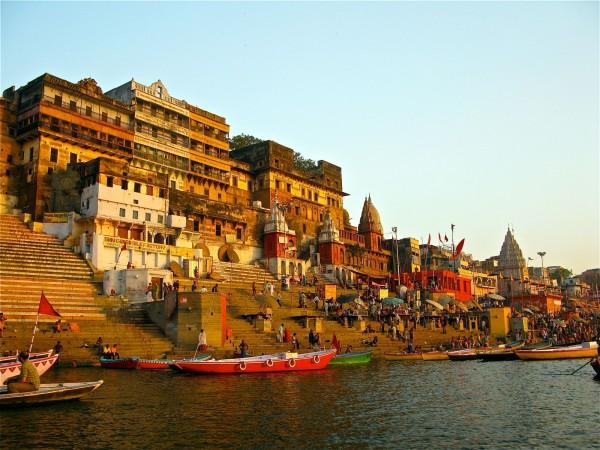
Overview of Varanasi
History & Cultural Influence
Varanasi, also known as Benares or Kashi, is one of the world's oldest continuously inhabited cities, with a history dating back to at least the 11th or 12th century BCE. Its historical significance and cultural influence have profoundly shaped the city's character.
Archaeological evidence suggests early settlement in the Ganga valley around Varanasi began in the 11th or 12th century BCE. The city quickly became a center for religious and philosophical activities, establishing its spiritual importance early on. Varanasi has been a major center of Hinduism for millennia. It's considered one of the seven holiest cities in Hinduism and is believed to grant moksha (liberation from the cycle of rebirth). This has made it a major pilgrimage site, attracting devotees from across India and the world. The city was also significant in the development of Buddhism. Gautama Buddha is said to have given his first sermon at nearby Sarnath in the 6th century BCE.
The city's famous ghats (riverfront steps) and numerous temples, many dating back centuries, reflect its long history and cultural importance. These structures have become iconic symbols of the city.
Interaction with The Locals
When interacting with locals in Varanasi, visitors can expect a vibrant and diverse experience. Varanasi has a population of approximately 1.8 million people, predominantly Hindu with significant Muslim and other minority communities. The city attracts pilgrims and visitors from all over India, creating a diverse mix of cultures and languages.
Locals in Varanasi are generally welcoming and friendly towards tourists. The city's long history as a pilgrimage site and tourist destination has made residents accustomed to interacting with visitors from various backgrounds. Many locals, especially those working in tourism-related sectors, speak some English.

Varanasi overview - © kashi gov
Top attractions in Varanasi
Explore the spiritual heart of India in Varanasi, one of the world's oldest inhabited cities. Wander along the ghats of the Ganges, where you can witness timeless rituals and ceremonies that captivate the essence of Indian spirituality. Don't miss the majestic Kashi Vishwanath Temple, an iconic site dedicated to Lord Shiva, and experience the enchanting evening Ganga Aarti, a ritual that lights up the river with countless lamps, creating a truly magical atmosphere.
Ganges River
Location: Flows through the heart of Varanasi
The Ganges River, revered as a sacred waterway, is the spiritual lifeblood of Varanasi. Visitors can embark on soul-stirring boat rides, immersing themselves in the tranquil yet vibrant atmosphere that encapsulates this holy city.
Dashashwamedh Ghat
Location: Dashashwamedh Ghat Road, Bangali Tola, Varanasi, Uttar Pradesh
As the most lively and celebrated ghat in Varanasi, Dashashwamedh Ghat is renowned for its mesmerizing evening Ganga Aarti ceremony, where elaborate rituals and vibrant music create an unforgettable experience.
Kashi Vishwanath Temple
Location: Lahori Tola, Varanasi, Uttar Pradesh
The Kashi Vishwanath Temple, adorned with a gold-plated spire, stands as a monumental site dedicated to Lord Shiva. This temple is not only a spiritual haven but also a masterpiece of religious artistry, drawing devotees and tourists alike.
Sarnath
Location: Sarnath, Varanasi, Uttar Pradesh (about 10 km northeast of Varanasi)
Sarnath marks the site where Buddha delivered his first sermon, making it a cornerstone of Buddhist pilgrimage. The area is dotted with ancient ruins and the majestic Dhamek Stupa, offering a profound glimpse into Buddhist history and architecture.
Ramnagar Fort
Location: Ramnagar, Varanasi, Uttar Pradesh
Built in the 18th century, Ramnagar Fort is an impressive palace complex that showcases the grandeur of Mughal architecture. Located on the eastern bank of the Ganges, it provides a picturesque backdrop and a historic exploration site.
Assi Ghat
Location: merging point of Assi River and River Ganga, Varanasi, Uttar Pradesh
Assi Ghat, known for its serene environment, is the southernmost of the main ghats. It's a place where one can partake in morning yoga sessions and experience the spiritual calm of evening aartis.
Banaras Hindu University
Location: Banaras Hindu University Campus, Varanasi, Uttar Pradesh
Banaras Hindu University, one of the largest residential universities in Asia, is celebrated not only for its academic excellence but also for its beautiful campus. The university also houses the Bharat Kala Bhavan museum, which features a rich collection of Indian art and artifacts.
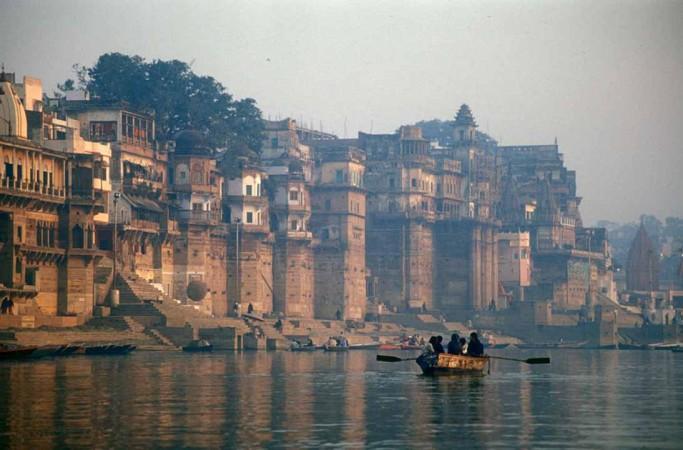
Ganges River - © Babasteve
Must-Try Dishes in Varanasi
Dive into the culinary landscape of Varanasi, where traditional flavors meet rich history. Savor the iconic Kachori Sabzi, a beloved breakfast of spicy curry paired with deep-fried bread, a perfect start to any day exploring the city. Indulge in Malaiyo, a winter delicacy made from frothy milk and saffron, capturing the essence of Varanasi’s sweet tooth. Don’t leave without trying the local Tamatar Chaat, a tangy tomato-based snack that will tantalize your taste buds with its blend of spices and crunchy bits.
Tamatar Chaat
Discover the zesty and spicy Tamatar Chaat, a unique street food specialty from Varanasi. This snack is a vibrant mix of roasted tomatoes, boiled potatoes, and a blend of spices, capturing the city's flair for bold and imaginative chaat creations.
Kachori Sabzi
Kachori Sabzi is a staple breakfast in Varanasi, featuring deep-fried pastry balls stuffed with spiced lentils, paired with a tangy potato curry. This indulgent meal highlights the city's penchant for deep-fried delights and its rich street food culture.
Malaiyo
Known locally as Nimish, Malaiyo is a winter favorite in Varanasi, a light and frothy dessert crafted from milk cream, infused with saffron and cardamom. Prepared in the cool early morning hours, this seasonal treat is cherished during the colder months.
Banarasi Paan
Banarasi Paan, more than just an after-meal refreshment, is a cultural icon of Varanasi. This preparation involves wrapping betel leaves around areca nuts and an assortment of sweet or savory fillings, epitomizing the culinary heritage and social customs of the city.
Choora Matar
Savor the warm and comforting Choora Matar during Varanasi's chilly winters. This breakfast dish blends flattened rice with green peas, ghee, and spices, showcasing how simple ingredients are transformed into satisfying and flavorful meals in Varanasi cuisine.

Tamatar Chaat - © gather
Festivals & Local Celebrations
Dev Deepawali
When: 15 days after Diwali (usually in November)
Dev Deepawali, the "Festival of Lights of the Gods," is a breathtaking celebration in Varanasi. Thousands of oil lamps light up the ghats along the Ganges River, creating a mesmerizing sight. The city is vibrant with colors, cultural performances, and special rituals, while boat rides provide stunning views of the illuminated riverfront.
Ganga Mahotsav
When: October/November (15 days before Diwali)
Ganga Mahotsav is a five-day festival that pays homage to the River Ganges. The event features classical music and dance performances by renowned artists at the ghats, highlighting Varanasi's rich cultural heritage and leading up to the grandeur of Dev Deepawali.
Maha Shivratri
When: February/March (14th day of the dark fortnight in Phalguna month)
Maha Shivratri is fervently celebrated in Varanasi, particularly at the Kashi Vishwanath Temple. The festival involves elaborate rituals, processions, and all-night vigils, filling the city with devotional songs and chants of "Om Namah Shivaya."
Bharat Milap
When: October/November (a few days after Dussehra)
Bharat Milap commemorates the reunion of Lord Ram with his brother Bharat after his 14-year exile. This event features elaborate processions and dramatic performances, especially prominent in the Nati Imli area of Varanasi. The appearance of the Kashi Naresh (King of Kashi) in ceremonial attire enhances the festival's grandeur.
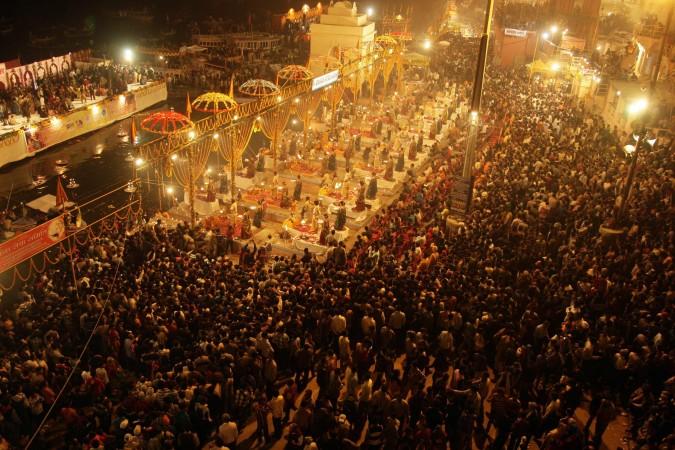
Dev Deepawali - © gather
Weather in Varanasi: Best Time to Visit
Varanasi experiences a subtropical climate with distinct seasonal variations, making it essential for travelers to understand the weather patterns to pack appropriately.
Average Temperatures
- Winter (November to February): Average temperatures range from 9.4°C (49°F) in January to 21.8°C (71°F). Nights can be cool, and fog is common, especially in December and January.
- Summer (March to June): This period is characterized by high temperatures, with averages reaching up to 40.5°C (105°F) in May. The heat can be intense, particularly in April and May.
- Monsoon (July to September): Average temperatures during this season range from 26.9°C (80°F) to 34.2°C (93°F). Rainfall is significant, especially in July and August, with July receiving around 260 mm (10.2 inches) of rain.
Rainfall
Varanasi receives an average annual rainfall of approximately 990 mm (39 inches), with the monsoon season from mid-June to early October being the wettest period. The driest month is typically December, with minimal rainfall.
Best Time to Travel
The best time to visit Varanasi is from mid-November to mid-February, when the weather is cooler and more comfortable for exploring the city's attractions. However, visitors should be aware that pollution levels can be high during this period.
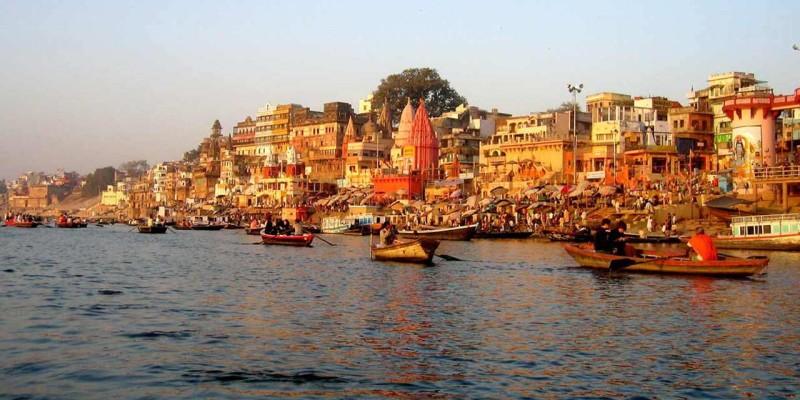
Dashashwamedh Ghat - © gather
Culture Etiquette in Varanasi
Dress Modestly
When visiting Varanasi, especially temples or religious sites, it's important for both men and women to wear clothing that covers shoulders, chest, and knees to respect local customs.
Remove Footwear
Always remove your shoes before entering temples or homes. Look for designated areas to store footwear as this practice is a sign of respect and cleanliness.
Respect Religious Practices
Varanasi is a hub of spiritual activity. Show respect for the city’s religious rituals, ceremonies, and the pilgrims, particularly along the vibrant ghats.
Photography Etiquette
Be mindful with your camera, especially at religious ceremonies or cremation ghats. Always ask for permission before photographing people, and adhere to local rules which might restrict photography in sacred areas.
Use of Right Hand
In Varanasi, it is customary to use your right hand for eating and for giving or receiving items, as the left hand is traditionally considered unclean.
Greetings
Greet people with a "Namaste" and folded hands, a respectful and widely accepted greeting throughout India.
Temple Etiquette
Inside temples, follow local customs such as walking clockwise around shrines and refrain from touching the idols to show respect.
Ganges Rituals
If you participate in any rituals along the Ganges, it’s prudent to follow the guidance of locals or religious leaders to respect traditional practices.
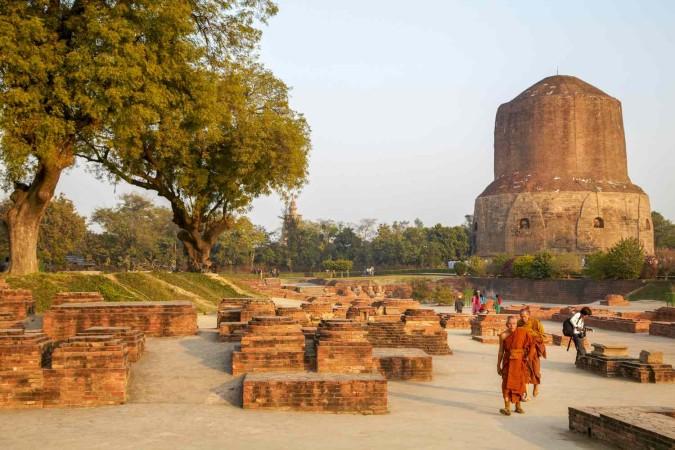
Sarnath - © gather
Essential Travel Information
Transportation
Airport Transfers
- Prepaid Taxi: Available at Lal Bahadur Shastri Airport, offering various vehicle options including Mini Cab, Micro Cab, Sedan Car, SUVs, and mini buses.
- Private Transfer Services: Companies like Suntransfers and Vidhan Travels offer pre-booked airport transfers with meet-and-greet services.
Taxis and Cab Services
- Local taxi services are available throughout the city.
- Prepaid taxi services can be booked online or via smartphone apps like Chiku Cab.
- Various vehicle options are available, from economy cars to luxury sedans and SUVs.
Articles for you

Explore Yala National Park - Sri Lanka Travel, Asia
Tucked away in Sri Lanka’s southeastern corner, Yala National Park is where wild nature meets deep tradition. Known worldwide for its leopard population, the park is also home to elephants, sloth bears, crocodiles, and hundreds of bird species. Beyond wildlife, Yala opens doors to a cultural landscape dotted with ancient temples, Buddhist ruins, and coastal villages. For travelers seeking more than just a safari, Yala offers a chance to explore eco-tourism, local communities, and sacred heritage sites.
Population: The Yala National Park area doesn’t have a human population.
Economy: The economy around Yala National Park thrives on a blend of eco-tourism, agriculture, and local services. Safari tours, eco-lodges, and cultural experiences drive steady income for nearby towns like Tissamaharama and Kataragama, supporting thousands of families.
Landmarks: Famous for Block I of Yala and wildlife encounters, including elephants, sloth bears, crocodiles, and exotic bird species.

Explore Galle - Sri Lanka Travel, Asia
Nestled on Sri Lanka’s southern coastline, Galle is a vibrant city where history meets the sea. Its cobbled streets, colonial architecture, and serene beaches make it a must-visit destination for travelers seeking a blend of culture, adventure, and relaxation. A UNESCO World Heritage site, Galle captivates visitors with its Dutch Fort, bustling markets, and friendly locals. Whether you’re exploring the ramparts at sunset or savoring fresh seafood by the shore, Galle promises an unforgettable journey into Sri Lanka’s heritage.
Population: Approximately 113,000 in 2023.
Economy: Galle’s economy thrives on tourism, trade, and fisheries. The city’s historic fort, colonial architecture, and coastal charm draw thousands of international visitors each year, making tourism its main economic driver. Fishing remains vital for local livelihoods, supplying fresh seafood across the region.
Landmarks: Famous for the Galle Fort, Dutch Reformed Church & Maritime Museum, and Unawatuna Beach.

Explore Bentota - Sri Lanka Travel, Asia
Nestled along Sri Lanka’s southwestern coast, Bentota is a tropical paradise that blends golden beaches, vibrant culture, and thrilling adventures. Famous for its calm waters, luxury resorts, and scenic river estuary, Bentota has become a top destination for travelers seeking both relaxation and authentic experiences. From serene beach walks at sunrise to adrenaline-pumping water sports, this coastal town offers a perfect balance of leisure and exploration. With its proximity to Colombo and Galle, Bentota is easy to reach, making it an ideal stop for both short escapes and extended holidays.
Population: Approximately 37,000 in 2023.
Economy: Bentota’s economy thrives mainly on tourism, which drives local businesses such as hotels, restaurants, and wellness retreats. The town also benefits from fishing, coconut cultivation, and handicrafts like wood carving and batik textiles. Many residents rely on the growing demand for water sports and Ayurvedic treatments, making tourism the backbone of both income and employment in the area.
Landmarks: Famous for Bentota Beach, Bentota River Safari, and Kande Vihara Temple.

Explore Mirissa - Sri Lanka Travel, Asia
Mirissa is a charming coastal town on Sri Lanka’s southern shoreline. Known for its golden beaches, turquoise waters, and vibrant marine life, it has become a must-visit stop for travelers exploring the island. Many come for whale watching, surfing, and sunset views at Coconut Tree Hill, but Mirissa offers much more than postcard beauty. The fishing boats you see anchored by the bay carry generations of stories. Local traditions, delicious cuisine, and a laid-back rhythm of life shape every visitor’s experience.
Population: Approximately 4,700 in 2023.
Economy: Mirissa’s economy is largely shaped by its coastal location. Fishing has long been the backbone of local livelihoods, with generations relying on the Indian Ocean for income. In recent decades, tourism has become the main driver of growth, thanks to whale watching, surfing, and beachside hospitality.
Landmarks: Famous for Mirissa Beach, Coconut Tree Hill, and Parrot Rock Bridge.

Explore Nuwara Eliya - Sri Lanka Travel, Asia
Tucked away in the Central Highlands of Sri Lanka, Nuwara Eliya is often called “Little England”. With its rolling tea plantations, cool misty mornings, and colonial charm, this mountain town feels like a step into another world. Travelers come here to breathe fresh air, walk through flower gardens, sip the finest Ceylon Tea, and enjoy a pace of life far from the island’s busy cities. Whether you’re drawn by scenic landscapes, heritage architecture, or the warmth of its people, Nuwara Eliya is a destination that blends nature, culture, and history in perfect harmony.
Population: Approximately 781,000 in 2023.
Economy: Nuwara Eliya’s economy thrives mainly on tea production, as it sits in the heart of Sri Lanka’s central highlands, famous worldwide for Ceylon Tea. The city also benefits from a growing tourism industry, attracting visitors with its colonial charm, cool climate, and scenic landscapes.
Landmarks: Famous for Gregory Lake, Hakgala Botanical Garden, and Victoria Park.

Explore Sukau - Malaysia Travel, Asia
Nestled on the banks of the Kinabatangan River in Sabah, Malaysian Borneo, Sukau is a destination where wildlife, culture, and conservation come together. Known as one of Asia’s top spots for river safaris and eco-tourism, this quiet village offers a front-row seat to encounters with Bornean orangutans, pygmy elephants, proboscis monkeys, and exotic birdlife.
Population: Approximately 1,400 in 2019.
Economy: Sukau’s economy is shaped by its riverine location and natural resources. Traditionally, the Orang Sungai community relied on fishing, small-scale farming, and forest gathering for their livelihood. Today, the village has shifted toward eco-tourism, with river cruises, jungle trekking, and homestays providing income.
Landmarks: Famous for the Kinabatangan River cruises, Gomantong Caves, and Ox-bow lakes and wetlands.
